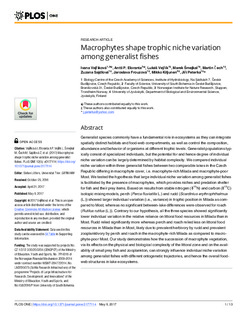| dc.contributor.author | Vejříková, Ivana | |
| dc.contributor.author | Eloranta, Antti | |
| dc.contributor.author | Vejřík, Lukáš | |
| dc.contributor.author | Šmejkal, Marek | |
| dc.contributor.author | Cech, Martin | |
| dc.contributor.author | Sajdlová, Zuzana | |
| dc.contributor.author | Frouzova, Jaroslava | |
| dc.contributor.author | Kiljunen, Mikko | |
| dc.contributor.author | Peterka, Jiří | |
| dc.coverage.spatial | Czech Republic , Tsjekkia | nb_NO |
| dc.date.accessioned | 2017-05-16T11:20:05Z | |
| dc.date.available | 2017-05-16T11:20:05Z | |
| dc.date.created | 2017-05-12T08:52:36Z | |
| dc.date.issued | 2017 | |
| dc.identifier.issn | 1932-6203 | |
| dc.identifier.uri | http://hdl.handle.net/11250/2442638 | |
| dc.description.abstract | Generalist species commonly have a fundamental role in ecosystems as they can integrate spatially distinct habitats and food-web compartments, as well as control the composition, abundance and behavior of organisms at different trophic levels. Generalist populations typically consist of specialized individuals, but the potential for and hence degree of individual niche variation can be largely determined by habitat complexity. We compared individual niche variation within three generalist fishes between two comparable lakes in the Czech Republic differing in macrophyte cover, i.e. macrophyte-rich Milada and macrophyte-poor Most. We tested the hypothesis that large individual niche variation among generalist fishes is facilitated by the presence of macrophytes, which provides niches and predation shelter for fish and their prey items. Based on results from stable nitrogen (δ15N) and carbon (δ13C) isotopic mixing models, perch (Perca fluviatilis L.) and rudd (Scardinius erythrophthalmus (L.)) showed larger individual variation (i.e., variance) in trophic position in Milada as compared to Most, whereas no significant between-lake differences were observed for roach (Rutilus rutilus (L.)). Contrary to our hypothesis, all the three species showed significantly lower individual variation in the relative reliance on littoral food resources in Milada than in Most. Rudd relied significantly more whereas perch and roach relied less on littoral food resources in Milada than in Most, likely due to prevalent herbivory by rudd and prevalent zooplanktivory by perch and roach in the macrophyte-rich Milada as compared to macrophyte- poor Most. Our study demonstrates how the succession of macrophyte vegetation, via its effects on the physical and biological complexity of the littoral zone and on the availability of small prey fish and zooplankton, can strongly influence individual niche variation among generalist fishes with different ontogenetic trajectories, and hence the overall foodweb structures in lake ecosystems. | nb_NO |
| dc.language.iso | eng | nb_NO |
| dc.rights | Navngivelse 4.0 Internasjonal | * |
| dc.rights.uri | http://creativecommons.org/licenses/by/4.0/deed.no | * |
| dc.title | Macrophytes shape trophic niche variation among generalist fishes | nb_NO |
| dc.type | Journal article | nb_NO |
| dc.type | Peer reviewed | nb_NO |
| dc.description.version | publishedVersion | |
| dc.subject.nsi | VDP::Zoologiske og botaniske fag: 480 | nb_NO |
| dc.subject.nsi | VDP::Zoology and botany: 480 | nb_NO |
| dc.source.pagenumber | e0177114 | nb_NO |
| dc.source.volume | 12 | nb_NO |
| dc.source.journal | PLoS ONE | nb_NO |
| dc.source.issue | 5 | nb_NO |
| dc.identifier.doi | https://doi.org/10.1371/journal.pone.0177114 | |
| dc.identifier.cristin | 1469787 | |
| dc.relation.project | LM2015075. 158/2016/P. Det europeiske økonomiske samarbeidsområde (EØS): 7F14316. CZ.1.07/2.3.00/20.0204. | nb_NO |
| cristin.unitcode | 7511,3,0,0 | |
| cristin.unitname | Avdeling for akvatisk økologi | |
| cristin.ispublished | true | |
| cristin.fulltext | original | |
| cristin.qualitycode | 1 | |

